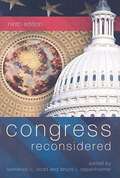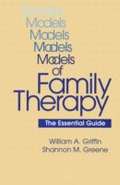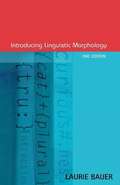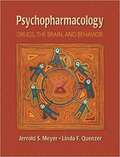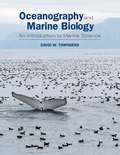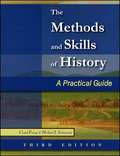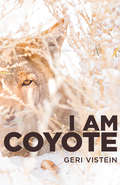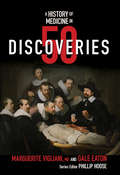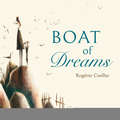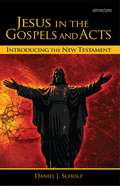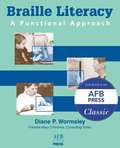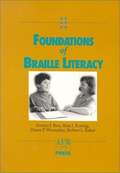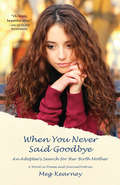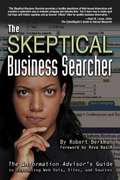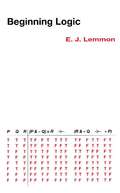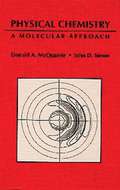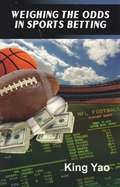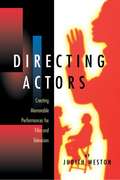- Table View
- List View
Keeping the Republic: Power and Citizenship in American Politics
by Christine Barbour Gerald C. WrightUnited States -- Politics and government -- Textbook
Congress Reconsidered, 9th Edition
by Lawrence C. Dodd Bruce I. OppenheimerAlways a classic, Dodd and Oppenheimer's Congress Reconsidered is the recognized source for in-depth, cutting-edge scholarship on Congress geared to undergraduates. Thoroughly updated -- with ten brand new pieces and the others completely revised -- this ninth edition includes cogent, timely analysis of the 2008 congressional elections, as well as coverage of: <P><P> * the 110th Democratic Congress,specifically its energy policy, its handling of the Iraq War, and its taxing and spending; <P> * the role of committees in Congress; <P> * leadership by women and minorities in Congress; <P> * the effects of campaign finance reform; <P> * differences in legislative activity between the Republican and Democratic Congresses; <P> * party coalition-building across the postwar era; <P> * and perspective on campaigns, elections,and political careers from member of Congress Daniel Lipinski.
Models of Family Therapy: The Essential Guide
by Williams A. Griffin Shannon M. GreeneModels of Family Therapy provides an overview of established family therapy models. All classification schemes of family therapy models must reduce ideological complexity, ignore overlap, and generalize for the purposes of category inclusion and exclusion. Nonetheless, orientation differences do exist and the authors make these differences clear by placing ideas and methods into categories. To facilitate learning how the dimensions of each model "fit" with other models, this book enhances comparability by using the same general outline in all chapters. In these outlines, the critical components of each model are broken down into a few core assumptions, terms, techniques, and methods. These critical components are summarized consistent with their description in the original publications. Some of these models include structural, strategic, behavioral, psychoeducational, and experiential therapy. Because of the style of presentation, this book can be useful as a primary text or supplement in a marriage and family therapy course. In addition, graduate students and professionals can benefit from this guidebook in order to prepare for any state or national examination on marriage and family therapy.
Integrated Mathematics: Course 3 (Second Edition)
by Edward P. Keenan Ann Xavier GantertThis Second Edition is offered to help students comprehend, master, and enjoy mathematics from an integrated point of view.
Introducing Linguistic Morphology
by Laurie BauerA newly expanded and updated edition of one of the best-selling introductions to linguistic morphology -- the study and description of word formations in languages -- that deals with inflection, derivation, and compounding, the system of word-forming elements and processes in a language. Basic concepts are introduced, with an abundance of examples from a range of familiar and exotic languages, followed by a discussion of, among other topics, the definition of word-form, productivity, inflection versus derivation, and the position of morphology to phonology -- the science of speech sounds, especially the history and theory of sound changes in a language. Along with two new chapters discussing morphology and the brain and how morphology arises, changes, and disappears, this new edition includes exercises and a glossary of key terms.
Psychopharmacology: Drugs, the Brain, and Behaviors (2nd Edition)
by Richard A. Harvey Michelle A. Clark Richard Finkel Jose A. Rey Karen WhalenRecent advances in molecular pharmacology and brain imaging have revolutionized our understanding of how psychoactive drugs work. Now, from the authors of Principles of Neuropsychopharmacology, comes a new undergraduate textbook integrating these developments. The first section of the book provides extensive foundation materials, including the basic principles of pharmacology, neurophysiology and neuroanatomy, synaptic transmission, and methods in psychopharmacology. The second section describes key features of major neurotransmitter systems, including the catecholamines, serotonin, acetylcholine, glutamate and GABA. The third and fourth sections discuss theories and mechanisms of drug addiction and psychopathology. All major substances of abuse as well as drugs used to treat mental illness are covered. Psychopharmacology: Drugs, the Brain and Behavior is unique in its breadth of coverage, ranging from historical accounts of drug use to clinical and preclinical behavioral studies to the latest research on drug effects in transgenic mouse models. Student engagement with the material is fostered by opening each chapter with a relevant vignette and by providing breakout boxes presenting novel or cutting-edge topics for special discussion. The book is extensively illustrated with full-color photographs and line art depicting important concepts and experimental data. Psychopharmacology: Drugs, the Brain and Behavior is appropriate for undergraduate psychopharmacology or drugs and behavior courses that emphasize relationships between the behavioral effects of psychoactive drugs and their mechanisms of action.
Oceanography and Marine Biology: An Introduction to Marine Science
by David W. TownsendOceanography and Marine Biology preserves the basic elements of the physical, chemical, and geological aspects of the marine sciences, and merges those fundamentals into a broader framework of marine biology and ecology. Existing textbooks on oceanography or marine biology address the companion field only cursorily: very few pages in oceanography texts are devoted to marine biology, and vice versa. This new book overcomes that imbalance, bringing these disparate marine science text formats closer together, giving them more equal weight, and introducing more effectively the physical sciences by showing students with everyday examples how such concepts form the foundation upon which to build a better understanding of the marine environment in a changing world. Lecturer supplements will also be available.
The Methods and Skills of History: A Practical Guide (Third Edition)
by Conal Furay Michael J. SalevourisThe Methods and Skills of History: A Practical Guide, is a dynamic text/workbook that combines theory with "hands on" practice, providing engaging essays, documents, and exercises designed to make history more meaningful and accessible to student readers--whether they are majoring in history, taking a history course as an elective, or simply reading history on their own--as well as strengthen their critical-thinking and communication skills.
I Am Coyote
by Geri VisteinCoyote is three years old when she leaves her family in Algonquin Provincial Park in Ontario and embarks on a 500-mile odyssey eastward in search of a territory of her own and a mate to share it with. Journeying by night through the dead of winter, she endures extreme cold, hunger, and a harrowing crossing of the St. Lawrence River in Montreal before her cries of loneliness are finally answered in the wilds of Maine. The mate she finds must gnaw off a paw to escape a trap. The first coyotes in the northern U.S., they raise pups (losing several), experience summer plenty, winter hardship, playfulness, and unmistakable love and grief. Blending science and imagination with magical results, this story tells how coyotes may have populated a land desperately in need of a keystone predator, and no one who reads it will doubt the value of their ecological role. Told through the eyes of a coyote, this is a riveting story with mythic dimensions. A work of creative nonfiction that adheres to the highest standards of wildlife biology. With deep insights into wild canine behavior, penetrates the veil of "otherness" that separates us from the animals with whom we share the planet. An appendix explores the history and current status of coyotes in North America. Native Americans considered them tricksters, messengers, and companions. Given the disappearance of wolves, they are even more critical to ecosystem health today. The author explains how, without coyotes, prey species are weakened by disease and parasites. Geri Vistein speaks extensively about coyote-human interactions to a variety of audiences. She is a nationally recognized expert on the topic and maintains the website CoyoteLivesInMaine.com. A QR code in the book takes readers to a hauntingly beautiful recording of coyote song.
A History of Medicine in 50 Discoveries (History in 50 #0)
by Marguerite Vigliani Gale Eaton Phillip HooseVigliani and Eaton’s high-interest exploration of medicine begins in prehistory. The 5,000-year-old Iceman discovered frozen in the Alps may have treated his gallstones, Lyme disease, and hardening of the arteries with the 61 tattoos that covered his body—most of which matched acupuncture points—and the walnut-sized pieces of fungus he carried on his belt. The herbal medicines chamomile and yarrow have been found on 50,000-year-old teeth, and neatly bored holes in prehistoric skulls show that Neolithic surgeons relieved pressure on the brain (or attempted to release evil spirits) at least 10,000 years ago. From Mesopotamian pharmaceuticals and Ancient Greek sleep therapy through midwifery, amputation, bloodletting, Renaissance anatomy, bubonic plague, and cholera to the discovery of germs, X-rays, DNA-based treatments and modern prosthetics, the history of medicine is a wild ride through the history of humankind.
Boat of Dreams
by Rogério CoelhoSelected for the 2018 Bank Street College of Education Best Children’s Books of the Year 2017 NYPL Best Books for Kids List *2017 IPPY Independent Publishers Gold Medalist* *Starred Review School Library Journal* *Starred Review- Booklist**Brazil's 2015 Jabuti Award for best children's illustration* How does a fastidious old man with bowler, umbrella, suspenders, and a Salvador Dali mustache come to live on a deserted island? How does a boy come to live alone in an apparently deserted city? Are they separated by distance or by time? Does the man dream the boy? Does the boy dream the man? Is a blank paper in a floating bottle an invitation to imagine our futures? Is the man’s flying boat an encouragement to the boy to dream? Are the man and the boy the same person—the boy dwelling in the man’s memory? Is a message in a bottle the earthbound dreams of the elderly? Is a flying boat the unconstrained dreams of the young? This wordless, many-layered 80-page picture book invites all these interpretations and more. The intricately detailed illustrations reveal new wonders with each viewing. Neither children nor adults will ever tire of this wonderful testament to imagination, memory, and dreams.
Jesus In The Gospels And Acts: Introducing The New Testament
by Daniel J. ScholzEngaging, scholarly, and theologically honest, this introductory textbook will be welcomed by students and professors alike. What do we really know about Jesus and how do we know it? Jesus in the Gospels and Acts: Introducing the New Testament explores these questions from the perspective of the New Testament--specifically the four Gospels and the Acts of the Apostles, as well as the extracanonical gospels. Using language and concepts considerate of a religiously diverse undergraduate audience, the author explores issues of authorship, historicity, culture, and theology. Features include: "Check Your Reading" questions check the students' basic comprehension. "Do You Have the Basics?" puzzles check for comprehension through crosswords, word finds, sequencing, and matching activities. "Questions for Reflection" challenge the students to think more deeply about the reading's meaning and the implications for us today. "This book focuses on the central figure of the Christian Scriptures: Jesus. Arguably, no other figure in history has had more influence in shaping many of the religious and cultural norms in the world today. Whether you belong to a specific faith tradition or none at all, possessing a working knowledge of Jesus and the Gospels is important for religious, historical, and cultural literacy. " --from the author's introduction
A Handbook of Biological Investigation (Seventh Edition)
by Harrison W. Ambrose Katharine Peckham Ambrose Douglas J. Emlen Kerry L. BrightThis book is written as a reference aid to be used by biology students at any time they are first exposed to the scientific method and to original research. It guides the beginner through elementary experimental design, data collection and analysis, and the subsequent writing of a scientific report. In addition, it provides an introduction to the literature of biology and a basic search strategy for finding relevant, published information in a library.
Braille Literacy: A Functional Approach
by Diane P. WormsleyWormsley (program director, Professional Preparation Program in Education of Children with Visual and Multiple Disabilities, Pennsylvania College of Optometry) describes an approach to braille reading and writing instruction based on students' individual interests, needs, and goals. She offers general guidelines for a functional approach to braille literacy, then offers case studies of how the program can be modified for at-risk learners. The approach works with children and adults learning braille for the first time. B&w photos of instructional materials are included. Annotation ©2004 Book News, Inc., Portland, OR (booknews.com)
Foundations of Braille Literacy
by Evelyn J. Rex Alan J. Koenig Diane P. Wormsley Robert L. BakerHistorical perspectives on literacy for blind people; changing views on teaching, reading and writing; approaches and strategies for reading and writing Braille literacy.
When You Never Said Goodbye: A Novel in Poems and Journal Entries
by Meg KearneyAgainst the odds, eighteen-year-old Liz McLane, adoptee and aspiring poet, searches for her birth mother in this sensitive and daring novel told through her own accessible and moving poems and journal entries. A student at NYU in Greenwich Village, Liz McLane is pursuing her dream of becoming a poet and, at the same time, determined to find her birth mother, no matter what the results may be. Through her journals, Liz records her struggle to navigate adoption bureaucracy and laws. In spare and poignant poems, she confides her fears and her prayers. Could her birth mother be the unknown guitarist in Washington Square Park, who sings a soulful song in a strangely familiar voice? Against a backdrop of college life—classes on Alice Munro and Billy Collins and an active social life—and with the help of her sister, friends, and a private investigator, Liz summons the courage to face the truth about her mother and herself. This is an unforgettable novel full of heart that addresses the primary questions all adoptees must answer for themselves: who was the woman who gave me life, and why did she decide to give me away? Based on author Meg Kearney’s own experiences.
The Skeptical Business Searcher: The Information Advisor's Guide to Evaluating Web Data, Sites, and Sources
by Robert BerkmanFocusing on free sources, Berkman (editor of The Information Advisor newsletter) arms business searchers with techniques for finding reliable, accurate company and industry data on the Web. He covers strategies to use before turning to a Web search engine (libraries, pre-screened sources, indexes and directories, weblogs) but also has plenty to say about effective use of search engines themselves. He provides tips on evaluating information for reliability and bias, and discusses big-picture topics like building up personal knowledge and search intuition. Annotation ©2004 Book News, Inc., Portland, OR (booknews.com)
Alexander Graham Bell for Kids: His Life and Inventions, with 21 Activities (For Kids series #70)
by Mary Kay CarsonWinner of the 2019 AAAS/Subaru SB&F Prize for Excellence in Science Book Alexander Graham Bell invented not only the telephone, but also early versions of the phonograph, the metal detector, airplanes, and hydrofoil boats. This Scottish immigrant was also a pioneering speech teacher and a champion of educating those with hearing impairments, work he felt was his most important contribution to society. Bell worked with famous Americans such as Helen Keller and aviators Glenn Curtiss and Samuel P. Langley, and his inventions competed directly with those of Thomas Edison and the Wright Brothers. This unique biography includes a time line, a list of online resources, and 21 engaging hands-on activities to better appreciate Bell's remarkable accomplishments. Kids will: Construct a Pie Tin Telegraph and a Pizza Box Phonograph "See" and "feel" sound by building simple devices Communicate using American Sign Language Send secret messages using Morse code Investigate the properties of ailerons on a paper airplane Build and fly a tetrahedral kite And more!
Beginning Logic
by E. J. Lemmon..."The aim of the book is to provide the student with a good working knowledge of the prepositional and predicate calculi--the foundations upon which modern symbolic logic is built. Accordingly, emphasis is placed on the actual technique of proof-discovery."
Property Management (4th edition)
by Walter Roy Huber Arlette Lyons William H. PivarUnderstanding the use and meanings of the terminology found in this textbook is paramount to a successful career in the real estate property management field.
Essential Calculus with Applications
by D. Franklin Wright Spencer P. Hurd Bill D. NewThis edition provides a solid introductory base for the mastery of basic calculus. In particular, business and social science majors will be well prepared for the analysis and evaluation of function-based analytical materials in their fields.
Foundations of Kinesiology: Studying Human Movement and Health (Second Edition)
by Peter KlavoraFOUNDATIONS OF KINESIOLOGY (2nd ed.) is a textbook designed for senior high school and introductory college and university programs in kinesiology, physical education, and exercise science. The book explores the multifaceted world of kinesiology: the study of human movement and the body s response to exercise. It examines the systems, factors, and principles involved in human development within the context of society. Relevant fields in the study of kinesiology include anatomy, physiology, biomechanics, nutrition, motor learning and control, and sport psychology, sociology, and philosophy. The relevant career options available to students in the field are also examined.
Physical Chemistry: A Molecular Approach
by Donald A. Mcquarrie John D. SimonThis book provides a contemporary approach to the study of physical chemistry. By beginning with quantum chemistry, students will learn the fundamental principles upon which all modern physical chemistry is built.
Weighing the Odds in Sports Betting
by King YaoWeighing the Odds in Sports Betting explains how to beat such sports bets as season wins, parlay cards, first halves, totals, and March Madness pools.
Directing Actors: Creating Memorable Performances for Film and Television
by Judith WestonInternationally-renowned directing coach Weston demonstrates what constitutes a good performance, what actors want from a director, what directors do wrong, script analysis and preparation, how actors work, and shares insights into the director/actor relationship.

